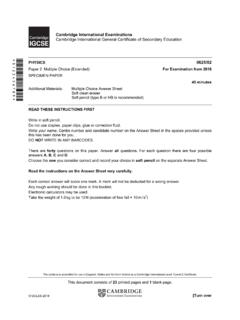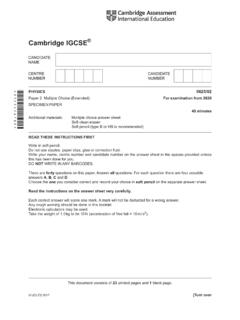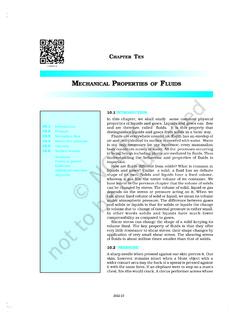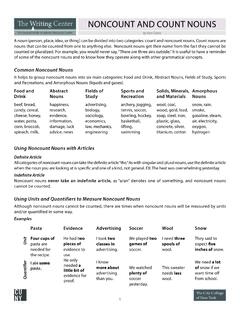Transcription of States of Matter - NASA
1 National Aeronautics and Space Administration States OF Matter NASA SUMMER OF INNOVATION UNIT Physical Science States of Matter GRADE LEVELS 4 6 CONNECTION TO CURRICULUM Science TEACHER PREPARATION TIME 2 hours LESSON TIME NEEDED 4 hours Complexity: Moderate LESSON DESCRIPTION This lesson explores the States of Matter and their properties. OBJECTIVES Students will Simulate the movement of atoms and molecules in solids, liquids, and gases Demonstrate the properties of liquids including density and buoyancy Investigate how the density of a solid behaves in varying densities of liquids Construct a rocket powered by pressurized gas created from a chemical reaction between a solid and a liquid NATIONAL STANDARDS National Science Education Standards (NSTA)
2 Science and Technology Abilities of technological design Understanding science and technology Physical Science Position and movement of objects Properties and changes in properties of Matter Transfer of energy MANAGEMENT For the first activity you may need to enhance prior knowledge about Matter and energy from a supplemental handout called Diagramming Atoms and Molecules in Motion. At the middle school level, this information about the invisible world of the atom is often presented as a story which we ask them to accept without much ready evidence. Since so many middle school students have not had science experience at the concrete operational level, they are poorly equipped to work at an abstract level.
3 However, in this activity students can begin to see evidence that supports the abstract information you are sharing with them. They can take notes on the first two descriptions as you present on the overhead. Emphasize the spacing of the particles, rather than the number. Say, In liquids the molecules are farther apart, rather than, In liquids there are fewer molecules. Although students may be uncomfortable thinking about things they cannot see, they should be reminded that the scientists who first developed these theories couldn't see atoms or molecules either. They may not have acted out the States of Matter with fellow scientists, but they definitely engaged in imagination exercises similar to those presented here.
4 Aerospace Education Services Project Aerospace Education Services Project 2 For the second activity where students create a liquid rainbow, students should never taste any chemical in the laboratory setting. If the students cannot guess correctly, then tell them they will learn the "secret ingredient" after the next step of the demonstration. Also, presenting the liquids as different colors eliminates the potential for students to pour the chemicals back into the dispensing container thereby contaminating a larger quantity. Tell them that all of the liquids used in this activity are colorless and that you have added color for safety and that the color has no effect on the results of the lab.
5 Remind students to never put the pipet or any substance in a lab in their mouths. The third activity is suggested as a demonstration. Prepare these solutions before students arrive in the class so they are not aware that there is a difference among solutions. For the fourth activity where the students build rockets, it may be helpful to make samples of rockets in various stages of completion available for students to study. This will help some students visualize the construction steps. Be sure to use white film canisters where the lid snaps inside the canister. CONTENT RESEARCH Matter commonly exists on Earth in three forms: solid , liquid , and gas.
6 These three forms are called the three States of Matter . Matter is usually found in only one form at ordinary Earth temperatures. The main difference between material in the solid state, the liquid state, and the gas state is how fast its molecules are moving. As a solid , the molecules are tightly packed and cannot move very much. As a liquid , the molecules have more space and can move about more. Gas molecules are moving very fast and are even farther apart. Water is unusual because it can be readily found on Earth in all three States . Although it is obvious that water vapor (not steam which is tiny liquid drops of water suspended in air) expands from its liquid volume, it may not be as obvious, and is definitely not the expected result, that ice also expands from its liquid volume.
7 If you have ever filled ice cube trays right to the rim, you may have noted that the resulting cubes stick up over the top of the tray. The expansion of liquid water into ice allows ice to float. This unique property of water is thought to be a factor that allows life to exist on our planet. Density is a property of Matter that can be introduced by thinking in terms of the relationship between weight and volume. How can two objects that are the same size have different weights? The answer has to do with their density. An object's density is determined by comparing its mass to its volume. If you compare a rock and a cork that are the same size having equal volume, which would be heavier?
8 The rock is, because it has more mass. Thus the rock is denser than the cork because it has more mass in the same volume. Liquids have density too. Unlike the densities of solids, which remain relatively constant, the densities of many fluids can be easily changed. Do objects float the same way in fresh water as they do in salt water? If you have the same amount of each, saltwater weighs more than fresh water. Salt water is described as being denser than fresh water. In the case of ocean water, heating, cooling, and salinity all influence density. Most of Earth's water (97%) is in the ocean. Seawater has unique properties: it is saline, its freezing point is slightly lower than fresh water, its density is slightly higher, its electrical conductivity is much higher, and it is slightly basic.
9 Circulation in the ocean depends in part on differences in density of the water. Water with more salt is denser (heavier) and sinks while fresh water is less dense and "floats" on the surface. When solutions of two different densities meet, the lower density (less dense) solution will move on top of the higher density (more dense) solution. The relationship between density of fluid, weight of an object, and buoyancy is a basic concept in understanding the behavior of seawater. These buoyancy differences can result in the separation of water into layers (stratification) within an estuary or ocean. Stratification can be disrupted by tidal mixing, heating and cooling of surface waters, and/or by wind generated water movement, such as waves and currents.
10 This action results in vertical mixing. Density-driven currents are an important feature in coastal waters, affecting the physical, chemical, and biological dynamics in the ocean. Many marine organisms use density currents for migration, reproduction, and feeding. Aerospace Education Services Project 3As seen from space, Earth has been described as a "blue marble," dominated by sapphire oceans and swirls of white clouds. Continents appear as widely spread outposts, covering less than one-third of the planet's surface. Earth is dominated by water in all its States of Matter : liquid seas, vaporous clouds, and solid ice. The interplay among these forms is depicted as a "water cycle.


















